Global Smart Access Control Market Forecast
- Global smart access control market size worth around US$1.4 Bn in 2022 poised to reach US$2.1 Bn by 2030-end
- Market valuation expected to expand at a CAGR of 5.1% over 2023 - 2030
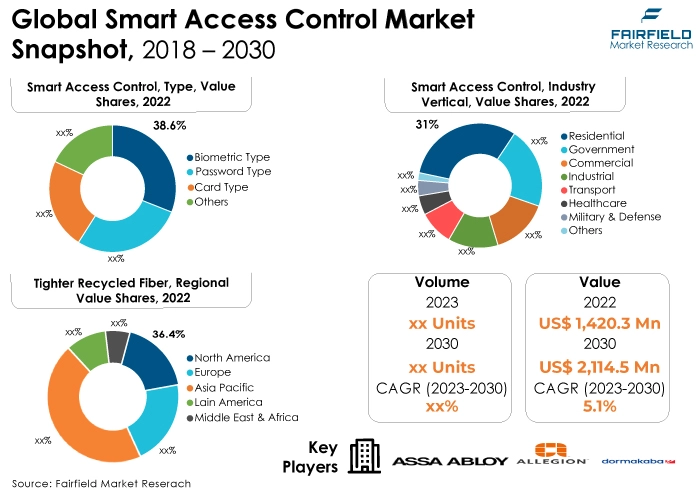
Quick Report Digest
- The key trend anticipated to fuel the growth of smart access control is the increasing demand from the residential industry.
- Another major market trend expected to fuel the growth is the smart access control market, a rapidly expanding global transport industry. The market is also predicted to profit from the growing worldwide transport industry.
- High costs associated with installation, maintenance, and ownership, coupled with access control environment, and supply chain stability, are hindering market growth and profitability.
- Biometric readers have secured the largest share in the smart access control market due to their unparalleled security and convenience. They offer highly accurate and contactless user authentication, reducing the risk of unauthorised access, which makes them a preferred choice for various access control applications and drives their market dominance.
- Due to the rising popularity of smart home technology, the residential sector now owns the greatest proportion of the global market for smart access control. Homeowners seek secure, convenient, and integrated access control solutions, contributing to the dominance of residential applications in the market.
- North America leads in the smart access control market due to its advanced technological infrastructure, high adoption rates, stringent security regulations, and significant investments in smart building projects. These factors have propelled the region to capture the largest market share.
- The Asia Pacific is expected to achieve the highest CAGR in the smart access control market due to rapid urbanisation, infrastructure development, expanding industries, and a rising focus on security and convenience, driving increased adoption of smart access control solutions in this dynamic and growing market.
- Security and privacy concerns present challenges in the smart access control market due to potential data breaches and unauthorised access. Adherence to data protection regulations and robust cybersecurity measures is crucial to mitigate these concerns and ensure trust and compliance among users and organisations.
A Look Back and a Look Forward - Comparative Analysis
The smart access control market is growing due to increasing security concerns, the need for convenient and contactless access management, and technological advancements. Organisations seek more sophisticated and integrated access control solutions, driven by factors like IoT integration, cloud-based solutions, regulatory requirements, and the expansion of smart cities and connected infrastructure, all of which contribute to the market growth.
The market witnessed staggered growth during the historical period 2018 – 2022. This is due to the substantial growth of the major end-use application sectors such as transport and healthcare. Stringent regulations drive the healthcare sector's growth in the smart access control market, the need to protect sensitive patient data and ensure patient safety. Access control solutions are crucial in managing secure access to healthcare facilities and complying with healthcare security standards, leading to increased adoption in this sector.
The prospects of the smart access control market look promising. Anticipated growth is fueled by increasing demand for security and convenience, integration with IoT and smart building systems, advancements in biometrics and mobile access technologies, and a growing emphasis on data privacy. The market is anticipated to grow further as these trends develop, delivering creative solutions to satisfy the shifting demands of various sectors.
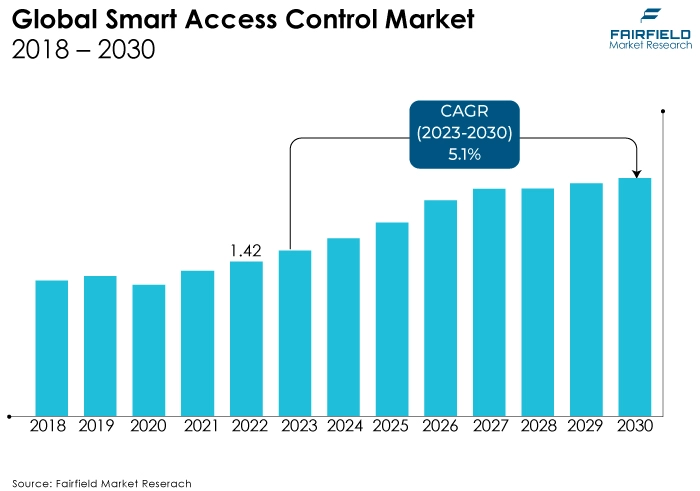
Key Growth Determinants
- Increasing Adoption of IoT-based Security Systems
The rising adoption of IoT-based security systems is a key driver propelling the growth of the smart access control market. IoT integration enhances access control systems by enabling real-time monitoring, remote management, and data analytics. This technology convergence provides businesses and homeowners with more comprehensive and flexible security solutions.
IoT-based access control systems offer features like biometric authentication, mobile access, and seamless integration with other smart devices. The ability to remotely control and monitor access through smartphones and web applications enhances convenience and security.
Furthermore, IoT-based systems generate valuable data insights, enabling predictive maintenance and improved security measures. As organisations prioritise enhanced safety and operational efficiency, the adoption of IoT-based access control systems is expected to continue driving the market's expansion.
- Growing Implementation of Mobile-based Access Control
The increasing implementation of mobile-based access control is a significant driver for the smart access control market. Mobile-based access solutions leverage smartphones as secure credentials, eliminating the need for physical keys and cards. This enhances convenience and security for users, enabling them to access controlled spaces with ease. Moreover, it simplifies management for businesses, allowing them to grant, revoke, or modify access remotely.
As companies and individuals seek more flexible and streamlined access control solutions, the adoption of mobile-based access is poised to propel the growth of the smart access control market.
- Unwavering Technology Innovations
Continuous technological innovations are propelling the smart access control market. Advancements such as biometric recognition, artificial intelligence, and cloud-based solutions have revolutionised access control systems. These innovations enhance security, offer more user-friendly experiences, and enable remote management and monitoring.
Moreover, integration with other smart devices, and the Internet of Things (IoT) opens new possibilities, making access control systems smarter and more versatile. As security needs evolve and the demand for seamless, efficient access management grows, technology innovations are a driving force behind the market's expansion.
Major Growth Barriers
- High Consts Associated with Installation, Maintenance, and Ownership
The smart access control market faces challenges due to the high installation, maintenance, and ownership costs associated with advanced access control systems. Initial setup expenses and ongoing maintenance can be prohibitive for some businesses.
Additionally, there needs to be more complexities in system integration, and the need for skilled personnel can further escalate costs. As a result, cost-sensitive organisations may be hesitant to adopt these solutions, hindering market growth.
Vendors are actively working to address these challenges by offering more cost-effective and user-friendly solutions to make smart access control more accessible to a wider range of users.
- Security And Privacy Concerns is Hindering Market Expansion
Security and privacy concerns pose significant challenges to the smart access control market. There is a higher danger of cyberattacks, and unauthorised access as access control systems grow increasingly linked and data-driven.
Stricter rules are being enacted as a result of privacy concerns around the collecting and storage of biometric data and personal information. Addressing these challenges requires robust cybersecurity measures, adherence to data protection regulations, and transparent privacy policies to ensure trust and confidence among users and organisations adopting smart access control solutions.
Key Trends and Opportunities to Look at
- Mobile Access Control
Mobile access control is a prominent trend in the smart access control market, leveraging smartphones as secure credentials. This technology allows users to unlock doors and gain access via mobile apps, enhancing convenience and reducing the need for physical cards or keys.
The technology offers flexibility, remote management capabilities, and the potential for seamless integration with other smart devices, making it a key driver in modern access control solutions.
- Biometric Authentication
Biometric authentication is a significant technology trend in the smart access control market, offering advanced security and convenience. Systems use biometric data like fingerprints, facial recognition, or iris scans to verify user identities.
Such a contactless and highly accurate authentication method is gaining prominence in access control, enhancing security and user experience while reducing the reliance on traditional access credentials like cards or PINs.
- Multi-factor Authentication (MFA)
Multi-factor authentication (MFA) is a pivotal trend in the smart access control market. It combines two or more authentication methods such as biometrics, PINs, or smart cards, to provide enhanced security.
MFA is gaining importance to safeguard access to critical areas or data, especially in high-security environments. Its effectiveness in preventing unauthorised access and ensuring identity verification makes it a key technology trend in access control solutions.
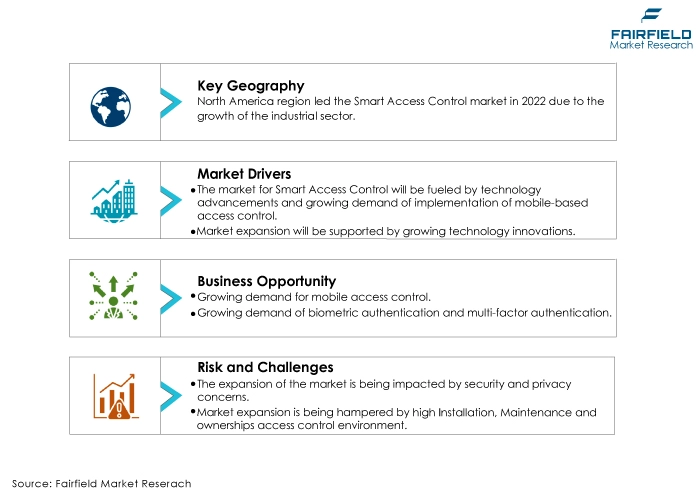
How Does the Regulatory Scenario Shape this Industry?
The regulatory environment plays a crucial role in shaping the smart access control market. Data protection and privacy obligations, such as GDPR in Europe or CCPA in California, impose stringent requirements on the collection, storage, and handling of personal data. Access control systems often deal with sensitive information, making compliance with these regulations imperative.
Furthermore, industry-specific regulations, such as those in healthcare or finance, influence the adoption of access control solutions to ensure compliance with security standards. Additionally, evolving cybersecurity regulations mandate robust security measures to protect against breaches and data theft, directly impacting access control technologies.
Compliance with these regulations not only ensures legal adherence but also instills trust in users, driving the demand for secure and privacy-conscious access control solutions in the market.
Fairfield’s Ranking Board
Top Segments
- Biometric Readers Capture the Largest Market Value Share
Biometric readers have captured the largest market share in the smart access control market due to their unmatched security and convenience. These readers use unique physiological traits like fingerprints, facial features, or iris scans for user authentication, making it extremely difficult for unauthorised access.
Biometrics eliminates the need for traditional access cards or PINs, reducing the risk of credential theft. As security concerns continue to rise, organisations increasingly favour biometric solutions for their reliability, accuracy, and ability to provide a seamless and contactless user experience, driving their dominance in the market.
Software on the other hand is expected to witness growing popularity, owing to its role in enhancing functionality and security. Advanced access control software offers features like remote management, real-time monitoring, and integration with other systems, making it indispensable in modern access control solutions.
As organisations seek more sophisticated and integrated access control systems to address evolving security needs, the demand for innovative and feature-rich software solutions is anticipated to grow rapidly, driving the high CAGR in this market segment.
- Residential Vertical Holds a Substantial Opportunity
Due to the rising popularity of smart home technologies, the residential sector has accumulated the highest market share in the smart access control industry. Homeowners are embracing access control solutions that offer convenience, security, and remote management through smartphones and other devices.
The desire for contactless and integrated security systems, combined with the expansion of the smart home market, has led to robust growth in residential access control deployments. As the trend toward smart homes continues, the residential sector is expected to maintain its dominant position in the market.
The healthcare sector presents the critical need for stringent security and access control measures, which is likely to create a lucrative opportunity for market players in the years to come. Healthcare facilities require advanced access control systems to protect sensitive patient data, control access to restricted areas, and ensure the safety of patients and staff.
The increasing emphasis on compliance with healthcare regulations, coupled with the integration of access control with healthcare IT systems, is driving the rapid adoption of smart access control solutions in the healthcare industry.
Regional Frontrunners
North America will be at the Forefrontw
North America region has captured the largest market share in the smart access control market due to several key factors. The region has a robust technological infrastructure and high adoption rates of smart technologies across various industries. Stringent regulatory requirements and a focus on security and privacy compliance have driven the adoption of advanced access control solutions.
Moreover, North America has a significant number of established players in the access control industry, offering a wide range of innovative solutions. The region's strong economy and investment in smart building projects, as well as a growing need for secure and efficient access control systems in various sectors, such as healthcare, commercial, and residential, contribute to its market dominance.
A proactive approach to adopting new technologies and a high awareness of security risks have further propelled North America to lead the smart access control market.
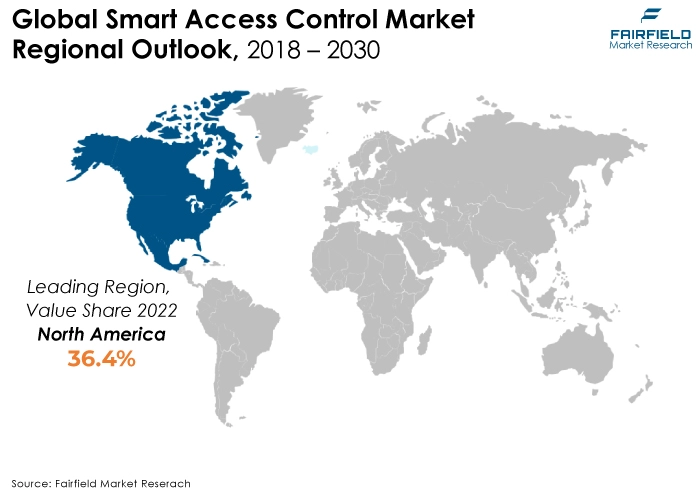
Asia Pacific Reaps Benefit from Smart Cty Initiatives
The Asia Pacific region is expected to achieve the highest CAGR in the smart access control market due to several factors. Rapid urbanisation, increasing infrastructure development, and a growing middle-class population are driving the demand for advanced access control systems in the commercial and residential sectors.
In addition, the adoption of smart city initiatives and the expansion of industries such as IT, manufacturing, and healthcare are fueling the need for sophisticated access control solutions. As the region embraces digitalisation and modernisation, the Asia Pacific market is poised for substantial growth in the smart access control sector.
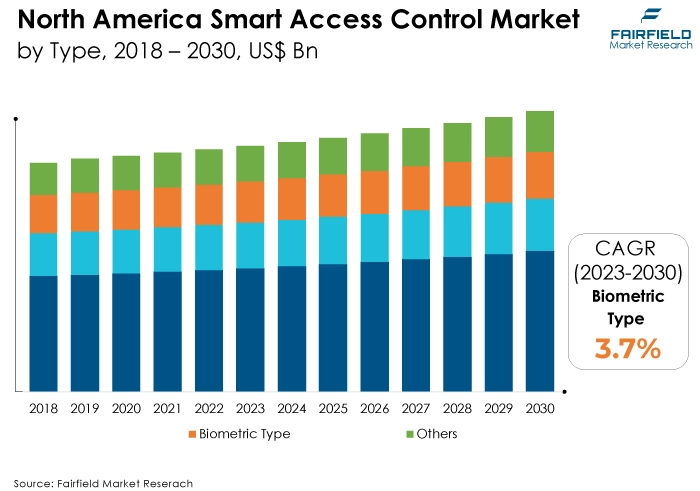
Fairfield’s Competitive Landscape Analysis
The global smart access control market is consolidated, with fewer major players present globally. The key players are introducing new products and working on the distribution channels to enhance their worldwide presence. Moreover, Fairfield Market Research expects more consolidation over the coming years.
Who are the Leaders in the Global Smart access control space?
- Assa Abloy
- Allegion
- Dormakaba
- Honeywell
- Johnson Controls
- HID Global
- Bosch Security Systems
- Salto Systems
- Nortek Control
- Feenics
- Tyco Security Products
- Brivo
- Openpath
- Kisi
- ProdataKey
Significant Company Developments
New Product Launches
- March 2023: Axis Communications and Genetec Inc. have collaborated to introduce an innovative enterprise-level access control solution called Axis. This unique offering integrates Genetec's access control software with Axis network door controllers into a single, easily deployable package. Notably, it is the inaugural solution of its kind in the market, harnessing Genetec technology to deliver unified security, public safety, operational efficiency, and business intelligence solutions.
- February 2023: Air Canada has unveiled an innovative digital facial recognition pilot program intended for specific flights between Vancouver and Winnipeg, as well as eligible patrons frequenting the Air Canada Café at Toronto Pearson International Airport. This initiative marks Air Canada as the pioneer in Canada to provide such technology to its clientele. The primary objective is to simplify the boarding procedures, diminish wait times, and enhance overall operational efficiency. Air Canada envisions expanding this service to additional Canadian airports and Maple Leaf Lounges in the future.
Distribution Agreement
- October 2022: ASSA ABLOY AB has successfully finalised the acquisition of ALCEA, a company based in France that specialises in access control solutions. ALCEA will be seamlessly integrated into ASSA ABLOY's Critical Infrastructure business portfolio, a move that strengthens the company's position in safeguarding critical infrastructure environments. This acquisition also extends the scope of ASSA ABLOY's access-focused product offerings, allowing for a broader range of solutions in this sector.
An Expert’s Eye
Demand and Future Growth
The exploding smartphone sales are driving the market. The smart access control market is poised for robust future growth due to increasing market demand. The demand for smart access control solutions is on the rise, driven by growing concerns about security and the need for convenient access management. As technology continues to advance, the market is expected to experience substantial growth.
Future growth will be fueled by factors such as the integration of access control with IoT devices, the adoption of cloud-based solutions, and the expansion of smart cities and connected infrastructure. Additionally, evolving regulatory requirements will contribute to the market's continued growth.
Supply Side of the Market
The leading countries in the smart access control market are the United States, China, Japan, Germany, and the United Kingdom. The United States, and China are major players due to their robust technology sectors and large-scale adoption of smart access solutions. Japan is known for its innovative tech industry, while Germany boasts strong manufacturing capabilities.
The United Kingdom has a growing market driven by security concerns. These nations are at the forefront of developing and implementing advanced smart access control systems, contributing significantly to the global market's growth and innovation.
In the smart access control market, key raw materials include electronic components such as RFID and NFC chips, biometric sensors, and touchscreen interfaces. Additionally, durable materials like metals and plastics are needed for hardware components such as locks and access control panels.
Software development requires programming languages, databases, and cloud services. Power sources like batteries or electrical wiring are essential, and connectivity relies on Wi-Fi, Bluetooth, or cellular modules. Lastly, data storage and cybersecurity measures are crucial to safeguard sensitive information in smart access control systems.
Global Smart Access Control Market is Segmented as Below:
By Type:
- Biometric Readers
- Electronic Locks
- Software
- Others
By Industry Vertical:
- Residential
- Government
- Commercial
- Industrial
- Transport
- Healthcare
- Military & Defence
- Others
By Geographic Coverage:
- North America
- U.S.
- Canada
- Europe
- Germany
- U.K.
- France
- Italy
- Turkey
- Russia
- Rest of Europe
- Asia Pacific
- China
- Japan
- South Korea
- India
- Southeast Asia
- Rest of Asia Pacific
- Latin America
- Brazil
- Mexico
- Argentina
- Rest of Latin America
- Middle East & Africa
- GCC
- South Africa
- Egypt
- Nigeria
- Rest of the Middle East & Africa
1. Executive Summary
1.1. Global Smart Access Control Market Snapshot
1.2. Future Projections
1.3. Key Market Trends
1.4. Regional Snapshot, by Value, 2022
1.5. Analyst Recommendations
2. Market Overview
2.1. Market Definitions and Segmentations
2.2. Market Dynamics
2.2.1. Drivers
2.2.2. Restraints
2.2.3. Market Opportunities
2.3. Value Chain Analysis
2.4. Porter’s Five Forces Analysis
2.5. COVID-19 Impact Analysis
2.5.1. Supply
2.5.2. Demand
2.6. Impact of Ukraine-Russia Conflict
2.7. Economic Overview
2.7.1. World Economic Projections
2.8. PESTLE Analysis
3. Global Smart Access Control Market Outlook, 2018 - 2030
3.1. Global Smart Access Control Market Outlook, by Type, Value (US$ Bn), 2018 - 2030
3.1.1. Key Highlights
3.1.1.1. Card Type
3.1.1.2. Password Type
3.1.1.3. Biometric Type
3.1.1.4. Others
3.2. Global Smart Access Control Market Outlook, by Industry Vertical, Value (US$ Bn), 2018 - 2030
3.2.1. Key Highlights
3.2.1.1. Residential
3.2.1.2. Government
3.2.1.3. Commercial
3.2.1.4. Industrial
3.2.1.5. Transport
3.2.1.6. Healthcare
3.2.1.7. Military & Defence
3.2.1.8. Others
3.3. Global Smart Access Control Market Outlook, by Region, Value (US$ Bn), 2018 - 2030
3.3.1. Key Highlights
3.3.1.1. North America
3.3.1.2. Europe
3.3.1.3. Asia Pacific
3.3.1.4. Latin America
3.3.1.5. Middle East & Africa
4. North America Smart Access Control Market Outlook, 2018 - 2030
4.1. North America Smart Access Control Market Outlook, by Type, Value (US$ Bn), 2018 - 2030
4.1.1. Key Highlights
4.1.1.1. Card Type
4.1.1.2. Password Type
4.1.1.3. Biometric Type
4.1.1.4. Others
4.2. North America Smart Access Control Market Outlook, by Industry Vertical, Value (US$ Bn), 2018 - 2030
4.2.1. Key Highlights
4.2.1.1. Residential
4.2.1.2. Government
4.2.1.3. Commercial
4.2.1.4. Industrial
4.2.1.5. Transport
4.2.1.6. Healthcare
4.2.1.7. Military & Defence
4.2.1.8. Others
4.2.2. BPS Analysis/Market Attractiveness Analysis
4.3. North America Smart Access Control Market Outlook, by Country, Value (US$ Bn), 2018 - 2030
4.3.1. Key Highlights
4.3.1.1. U.S. Smart Access Control Market Type, Value (US$ Bn), 2018 - 2030
4.3.1.2. U.S. Smart Access Control Market Industry Vertical, Value (US$ Bn), 2018 - 2030
4.3.1.3. Canada Smart Access Control Market Type, Value (US$ Bn), 2018 - 2030
4.3.1.4. Canada Smart Access Control Market Industry Vertical, Value (US$ Bn), 2018 - 2030
4.3.2. BPS Analysis/Market Attractiveness Analysis
5. Europe Smart Access Control Market Outlook, 2018 - 2030
5.1. Europe Smart Access Control Market Outlook, by Type, Value (US$ Bn), 2018 - 2030
5.1.1. Key Highlights
5.1.1.1. Card Type
5.1.1.2. Password Type
5.1.1.3. Biometric Type
5.1.1.4. Others
5.2. Europe Smart Access Control Market Outlook, by Industry Vertical, Value (US$ Bn), 2018 - 2030
5.2.1. Key Highlights
5.2.1.1. Residential
5.2.1.2. Government
5.2.1.3. Commercial
5.2.1.4. Industrial
5.2.1.5. Transport
5.2.1.6. Healthcare
5.2.1.7. Military & Defence
5.2.1.8. Others
5.2.2. BPS Analysis/Market Attractiveness Analysis
5.3. Europe Smart Access Control Market Outlook, by Country, Value (US$ Bn), 2018 - 2030
5.3.1. Key Highlights
5.3.1.1. Germany Smart Access Control Market Type, Value (US$ Bn), 2018 - 2030
5.3.1.2. Germany Smart Access Control Market Industry Vertical, Value (US$ Bn), 2018 - 2030
5.3.1.3. U.K. Smart Access Control Market Type, Value (US$ Bn), 2018 - 2030
5.3.1.4. U.K. Smart Access Control Market Industry Vertical, Value (US$ Bn), 2018 - 2030
5.3.1.5. France Smart Access Control Market Type, Value (US$ Bn), 2018 - 2030
5.3.1.6. France Smart Access Control Market Industry Vertical, Value (US$ Bn), 2018 - 2030
5.3.1.7. Italy Smart Access Control Market Type, Value (US$ Bn), 2018 - 2030
5.3.1.8. Italy Smart Access Control Market Industry Vertical, Value (US$ Bn), 2018 - 2030
5.3.1.9. Turkey Smart Access Control Market Type, Value (US$ Bn), 2018 - 2030
5.3.1.10. Turkey Smart Access Control Market Industry Vertical, Value (US$ Bn), 2018 - 2030
5.3.1.11. Russia Smart Access Control Market Type, Value (US$ Bn), 2018 - 2030
5.3.1.12. Russia Smart Access Control Market Industry Vertical, Value (US$ Bn), 2018 - 2030
5.3.1.13. Rest of Europe Smart Access Control Market Type, Value (US$ Bn), 2018 - 2030
5.3.1.14. Rest of Europe Smart Access Control Market Industry Vertical, Value (US$ Bn), 2018 - 2030
5.3.2. BPS Analysis/Market Attractiveness Analysis
6. Asia Pacific Smart Access Control Market Outlook, 2018 - 2030
6.1. Asia Pacific Smart Access Control Market Outlook, by Type, Value (US$ Bn), 2018 - 2030
6.1.1. Key Highlights
6.1.1.1. Card Type
6.1.1.2. Password Type
6.1.1.3. Biometric Type
6.1.1.4. Others
6.2. Asia Pacific Smart Access Control Market Outlook, by Industry Vertical, Value (US$ Bn), 2018 - 2030
6.2.1. Key Highlights
6.2.1.1. Residential
6.2.1.2. Government
6.2.1.3. Commercial
6.2.1.4. Industrial
6.2.1.5. Transport
6.2.1.6. Healthcare
6.2.1.7. Military & Defence
6.2.1.8. Others
6.2.2. BPS Analysis/Market Attractiveness Analysis
6.3. Asia Pacific Smart Access Control Market Outlook, by Country, Value (US$ Bn), 2018 - 2030
6.3.1. Key Highlights
6.3.1.1. China Smart Access Control Market Type, Value (US$ Bn), 2018 - 2030
6.3.1.2. China Smart Access Control Market by Industry Vertical, Value (US$ Bn), 2018 - 2030
6.3.1.3. Japan Smart Access Control Market Type, Value (US$ Bn), 2018 - 2030
6.3.1.4. Japan Smart Access Control Market Industry Vertical, Value (US$ Bn), 2018 - 2030
6.3.1.5. South Korea Smart Access Control Market Type, Value (US$ Bn), 2018 - 2030
6.3.1.6. South Korea Smart Access Control Market Industry Vertical, Value (US$ Bn), 2018 - 2030
6.3.1.7. India Smart Access Control Market Type, Value (US$ Bn), 2018 - 2030
6.3.1.8. India Smart Access Control Market Industry Vertical, Value (US$ Bn), 2018 - 2030
6.3.1.9. Southeast Asia Smart Access Control Market Type, Value (US$ Bn), 2018 - 2030
6.3.1.10. Southeast Asia Smart Access Control Market Industry Vertical, Value (US$ Bn), 2018 - 2030
6.3.1.11. Rest of Asia Pacific Smart Access Control Market Type, Value (US$ Bn), 2018 - 2030
6.3.1.12. Rest of Asia Pacific Smart Access Control Market Industry Vertical, Value (US$ Bn), 2018 - 2030
6.3.2. BPS Analysis/Market Attractiveness Analysis
7. Latin America Smart Access Control Market Outlook, 2018 - 2030
7.1. Latin America Smart Access Control Market Outlook, by Type, Value (US$ Bn), 2018 - 2030
7.1.1. Key Highlights
7.1.1.1. Card Type
7.1.1.2. Password Type
7.1.1.3. Biometric Type
7.1.1.4. Others
7.2. Latin America Smart Access Control Market Outlook, by Industry Vertical, Value (US$ Bn), 2018 - 2030
7.2.1. Key Highlights
7.2.1.1. Residential
7.2.1.2. Government
7.2.1.3. Commercial
7.2.1.4. Industrial
7.2.1.5. Transport
7.2.1.6. Healthcare
7.2.1.7. Military & Defence
7.2.1.8. Others
7.2.2. BPS Analysis/Market Attractiveness Analysis
7.3. Latin America Smart Access Control Market Outlook, by Country, Value (US$ Bn), 2018 - 2030
7.3.1. Key Highlights
7.3.1.1. Brazil Smart Access Control Market Type, Value (US$ Bn), 2018 - 2030
7.3.1.2. Brazil Smart Access Control Market Industry Vertical, Value (US$ Bn), 2018 - 2030
7.3.1.3. Mexico Smart Access Control Market Type, Value (US$ Bn), 2018 - 2030
7.3.1.4. Mexico Smart Access Control Market Industry Vertical, Value (US$ Bn), 2018 - 2030
7.3.1.5. Argentina Smart Access Control Market Type, Value (US$ Bn), 2018 - 2030
7.3.1.6. Argentina Smart Access Control Market Industry Vertical, Value (US$ Bn), 2018 - 2030
7.3.1.7. Rest of Latin America Smart Access Control Market Type, Value (US$ Bn), 2018 - 2030
7.3.1.8. Rest of Latin America Smart Access Control Market Industry Vertical, Value (US$ Bn), 2018 - 2030
7.3.2. BPS Analysis/Market Attractiveness Analysis
8. Middle East & Africa Smart Access Control Market Outlook, 2018 - 2030
8.1. Middle East & Africa Smart Access Control Market Outlook, by Type, Value (US$ Bn), 2018 - 2030
8.1.1. Key Highlights
8.1.1.1. Card Type
8.1.1.2. Password Type
8.1.1.3. Biometric Type
8.1.1.4. Others
8.2. Middle East & Africa Smart Access Control Market Outlook, by Industry Vertical, Value (US$ Bn), 2018 - 2030
8.2.1. Key Highlights
8.2.1.1. Residential
8.2.1.2. Government
8.2.1.3. Commercial
8.2.1.4. Industrial
8.2.1.5. Transport
8.2.1.6. Healthcare
8.2.1.7. Military & Defence
8.2.1.8. Others
8.2.2. BPS Analysis/Market Attractiveness Analysis
8.3. Middle East & Africa Smart Access Control Market Outlook, by Country, Value (US$ Bn), 2018 - 2030
8.3.1. Key Highlights
8.3.1.1. GCC Smart Access Control Market Type, Value (US$ Bn), 2018 - 2030
8.3.1.2. GCC Smart Access Control Market Industry Vertical, Value (US$ Bn), 2018 - 2030
8.3.1.3. South Africa Smart Access Control Market Type, Value (US$ Bn), 2018 - 2030
8.3.1.4. South Africa Smart Access Control Market Industry Vertical, Value (US$ Bn), 2018 - 2030
8.3.1.5. Egypt Smart Access Control Market Type, Value (US$ Bn), 2018 - 2030
8.3.1.6. Egypt Smart Access Control Market Industry Vertical, Value (US$ Bn), 2018 - 2030
8.3.1.7. Nigeria Smart Access Control Market Type, Value (US$ Bn), 2018 - 2030
8.3.1.8. Nigeria Smart Access Control Market Industry Vertical, Value (US$ Bn), 2018 - 2030
8.3.1.9. Rest of Middle East & Africa Smart Access Control Market Type, Value (US$ Bn), 2018 - 2030
8.3.1.10. Rest of Middle East & Africa Smart Access Control Market Industry Vertical, Value (US$ Bn), 2018 - 2030
8.3.2. BPS Analysis/Market Attractiveness Analysis
9. Competitive Landscape
9.1. Industry Vertical vs Industry Vertical Heatmap
9.2. Manufacturer vs Industry Vertical Heatmap
9.3. Company Market Share Analysis, 2022
9.4. Competitive Dashboard
9.5. Company Profiles
9.5.1. Assa Abloy
9.5.1.1. Company Overview
9.5.1.2. Product Portfolio
9.5.1.3. Financial Overview
9.5.1.4. Business Strategies and Development
9.5.2. Allegion
9.5.2.1. Company Overview
9.5.2.2. Product Portfolio
9.5.2.3. Financial Overview
9.5.2.4. Business Strategies and Development
9.5.3. Dormakaba
9.5.3.1. Company Overview
9.5.3.2. Product Portfolio
9.5.3.3. Financial Overview
9.5.3.4. Business Strategies and Development
9.5.4. Honeywell
9.5.4.1. Company Overview
9.5.4.2. Product Portfolio
9.5.4.3. Financial Overview
9.5.4.4. Business Strategies and Development
9.5.5. Johnson Controls
9.5.5.1. Company Overview
9.5.5.2. Product Portfolio
9.5.5.3. Financial Overview
9.5.5.4. Business Strategies and Development
9.5.6. HID Global
9.5.6.1. Company Overview
9.5.6.2. Product Portfolio
9.5.6.3. Financial Overview
9.5.6.4. Business Strategies and Development
9.5.7. Bosch Security Systems
9.5.7.1. Company Overview
9.5.7.2. Product Portfolio
9.5.7.3. Financial Overview
9.5.7.4. Business Strategies and Development
9.5.8. Salto Systems
9.5.8.1. Company Overview
9.5.8.2. Product Portfolio
9.5.8.3. Financial Overview
9.5.8.4. Business Strategies and Development
9.5.9. Nortek Control
9.5.9.1. Company Overview
9.5.9.2. Product Portfolio
9.5.9.3. Financial Overview
9.5.9.4. Business Strategies and Development
9.5.10. Feenics
9.5.10.1. Company Overview
9.5.10.2. Product Portfolio
9.5.10.3. Financial Overview
9.5.10.4. Business Strategies and Development
9.5.11. Tyco Security Products
9.5.11.1. Company Overview
9.5.11.2. Product Portfolio
9.5.11.3. Financial Overview
9.5.11.4. Business Strategies and Development
9.5.12. Brivo
9.5.12.1. Company Overview
9.5.12.2. Product Portfolio
9.5.12.3. Financial Overview
9.5.12.4. Business Strategies and Development
9.5.13. Openpath
9.5.13.1. Company Overview
9.5.13.2. Product Portfolio
9.5.13.3. Financial Overview
9.5.13.4. Business Strategies and Development
9.5.14. Kisi
9.5.14.1. Company Overview
9.5.14.2. Product Portfolio
9.5.14.3. Financial Overview
9.5.14.4. Business Strategies and Development
9.5.15. ProdataKey
9.5.15.1. Company Overview
9.5.15.2. Product Portfolio
9.5.15.3. Financial Overview
9.5.15.4. Business Strategies and Development
10. Appendix
10.1. Research Methodology
10.2. Report Assumptions
10.3. Acronyms and Abbreviations
|
BASE YEAR |
HISTORICAL DATA |
FORECAST PERIOD |
UNITS |
|||
|
2022 |
|
2018 - 2022 |
2023 - 2030 |
Value: US$ Million |
||
|
REPORT FEATURES |
DETAILS |
|
Type Coverage |
|
|
Industrial Vertical Coverage |
|
|
Geographical Coverage |
|
|
Leading Companies |
|
|
Report Highlights |
Key Market Indicators, Macro-micro economic impact analysis, Technological Roadmap, Key Trends, Driver, Restraints, and Future Opportunities & Revenue Pockets, Porter’s 5 Forces Analysis, Historical Trend (2019-2021), Market Estimates and Forecast, Market Dynamics, Industry Trends, Competition Landscape, Category, Region, Country-wise Trends & Analysis, COVID-19 Impact Analysis (Demand and Supply Chain) |
